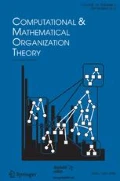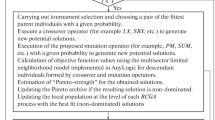Abstract
This paper offers an analysis of cluster formations on planer cells comprised of multi-agents utilizing local interactions and state transitions based on Genetic Programming (GP) and its applications. First, we illustrate that if the states of agents are allowed to have continuous values, equilibrium is attained on the basis of the fixed-point theorem. We also show that if the agents are restricted to binary states, equilibrium is attained in an asymptotic sense. However, for agents characterized by more than one state, the attainment of equilibrium is not ensured. We examine our results by using a simulation wherein agents learn from past experiences based on GP. Finally, we demonstrate a system comprised of cluster formations on planer cells comprised of artificial agents, and apply this system to the clustering of employees in firms.







Similar content being viewed by others
References
Alcacer J, Chung W (2007) Location strategies and knowledge spillovers. Manag Sci 53(5):760–776. doi:10.1287/mnsc.1060.0637
Arrow KJ, Debreu G (1954) Existence of an equilibrium for a competitive economy. Econometrica 22:265–290. doi:10.2307/1907353
Beckenbach F, Briegel R (2010) Multi-agent modeling of economic innovation dynamics and its implications for analyzing emission impacts. Int Econ Econ Policy 7(2):317–341. doi:10.1007/s10368-010-0167-7
Biggiero L, Sevi E (2009) Opportunism by cheating and its effects on industry profitability. The CIOPS model. Comput Math Organ Theory 15(3):191–236. doi:10.1007/s10588-009-9057-3
Bulter B (2001) Membership size, communication activity, and sustainability: a resource-based model of online social structures. Inf Syst Res 12(4):346–362. doi:10.1287/isre.12.4.346.9703
Burke K, Calton JM (2009) A framework describing the relationships among social technologies and social capital formation in electronic entrepreneurial networking. Int J e-Collab 5(3):25–38. doi:10.4018/jec.2009070102
Cheng Z, Nault BR (2007) Industry level supplier-driven IT spillovers. Manag Sci 53(8):1199–1216. doi:10.1287/mnsc.1060.0657
Fagiolo G (2005) Endogenous neighborhood formation in a local coordination model with negative network externalities. J Econ Dyn Control 29(1–2):297–319. doi:10.1016/j.jedc.2003.05.004
Frantz TL, Cataldo M, Carley KM (2009) Robustness of centrality measures under uncertainty: examining the role of network topology. Comput Math Organ Theory 15:303–328. doi:10.1007/s10588-009-9063-5
Flache A, Mas M (2008) How to get the timing right. A computational model of the effects of the timing of contacts on team cohesion in demographically diverse teams. Comput Math Organ Theory 14(1):23–51. doi:10.1007/s10588-008-9019-1
Grima S, Wakelin K (2007) Productivity spillovers from foreign direct investment: evidence from UK industry level panel data. Reg Sci Urban Econ 37:399–412. doi:10.1057/palgrave.jibs.8490914
Keith MJ, Martin MC (1994) Genetic programming in C++: implementation issues. In: Kinnerar KE (ed) Advance in genetic programming. MIT Press, Cambridge
Klos TB, Nooteboom B (2001) Agent-based computational transaction cost economics. J Econ Dyn Control 25:503–526. doi:10.1016/S0165-1889(00)00034-8
Koza JR (1992) Genetic programming: on the programming of computers by means of natural selection. MIT Press, Cambridge
Koza JR (1994) Genetic programming II: automatic discovery of reusable programs. MIT Press, Cambridge
König MD, Tessone CJ, Zenou Y (2010) From assortative to dissortative networks: the role of capacity constraints. Adv Complex Syst 13(4):483–499. doi:10.1142/S0219525910002700
Lu JJ, Tokinaga S (2008) Modeling firms-relation in modular production scheme considering the profit-sharing and reaction options and its applications. In: The proceedings of the seventh Wuhan international conference on E-business, pp 2454–2458
Lu JJ, Tokinaga S, Ikeda Y (2006) Explanatory rule extraction based on the trained neural network and the genetic programming. J Oper Res Soc Jpn 49(1):66–82
Lu JJ, Kishikawa Y, Tokinaga S (2007) Realization of feature description systems for clusters by rule generation based on genetic programming and its applications. Electron Commun Jpn, Part 2 90(9):87–97. doi:10.1002/ecjb.20380
Maeda Y, Imai H (2005) An agent based model on the bully of mobbed classmates. IEICE Trans Fundam J88-A(6):722–729 (in Japanese)
McAulay L (2007) Unintended consequences of computer-mediated communications. Behav Inf Technol 26(5):385–398. doi:10.1080/01449290500535343
Oh W, Jeon S (2007) Membership herding and network stability in the open source community: the Ising perspective. Manag Sci 53(7):1086–1101. doi:10.1287/mnsc.1060.0623
Oomes N (2003) Local trade networks and spatially persistent unemployment. J Econ Dyn Control 27:2115–2149. doi:10.1016/S0165-1889(02)00118-5
Outkin AV (2003) Cooperation and local interactions in the Prisoners’ Dilemma Game. J Econ Behav Organ 52(4):481–503. doi:10.1016/S0167-2681(02)00155-5
Pitt J, Ramirez-Cano D, Draief M, Artikis A (2011) Interleaving multi-agent systems and social networks for organized adaptation. Comput Math Organ Theory 17:344–378. doi:10.1007/s10588-011-9089-3
Raberto M, Teglio A, Cincotti S (2008) Integrating real and financial markets in an agent-based economic model: an application to monetary policy design. Comput Econ 32(1–2):147–162. doi:10.1007/s10614-008-9138-2
Read D (2010) Agent-based and multi-agent simulations: coming of age or in search of an identity? Comput Math Organ Theory 16:329–347. doi:10.1007/s10588-010-9067-1
Taifi N, Passiante G (2010) The strategic partners network’s extraction: the XStrat.Net project. Commun Comput Inf Sci 112(2):303–311. doi:10.1007/978-3-642-16324-1_32
Tesfatsion L (2001) Structure, behavior and market power in an evolutionary labor market with adaptive search. J Econ Dyn Control 25:419–457. doi:10.1016/S0165-1889(00)00032-4
Topa G (2001) Social interactions, local spillovers and unemployment. Rev Econ Stud 68:261–295. doi:0034-6527/01/00120261$02.00
Safarzyńska K, van den Bergh JCJM (2010) Evolutionary models in economics: a survey of methods and building blocks. J Evol Econ 20(3):329–373. doi:10.1007/s00191-009-0153-9
Scarf HE (1967) The approximation of fixed points of a continuous mapping. SIAM J Appl Math 15:1328–1343
Shoven JB, Whalley J (1992) Applying general equilibrium. Cambridge University Press, Cambridge
Van Alstyne M, Brynjolffson E (2005) Global village or cyber-Balkans? Modeling and measuring the integration of electronic communities. Manag Sci 51:851–868. doi:10.1287/mnsc.1050.0363
Yang JS, Kwon O, Jung WS, Kim IM (2008) Agent-based approach for generation of a money-centered star network. Phys A, Stat Mech Appl 387(22):5498–5502. doi:10.1016/j.physa.2008.05.025
Zou G, Yilmaz L (2010) Dynamics of knowledge creation in global participatory science communities: open innovation communities from a network perspective. Comput Math Organiz Theory 17(1):35–58. doi:10.1007/s10588-010-9068-0
Zhang Y, Wu Y (2011) How behaviors spread in dynamic social networks. Comput Math Organ Theory. doi:10.1007/s10588-011-9105-7
Author information
Authors and Affiliations
Corresponding author
Rights and permissions
About this article
Cite this article
Lu, J., Tokinaga, S. Analysis of cluster formations on planer cells based on genetic programming. Comput Math Organ Theory 19, 426–445 (2013). https://doi.org/10.1007/s10588-012-9112-3
Published:
Issue Date:
DOI: https://doi.org/10.1007/s10588-012-9112-3




